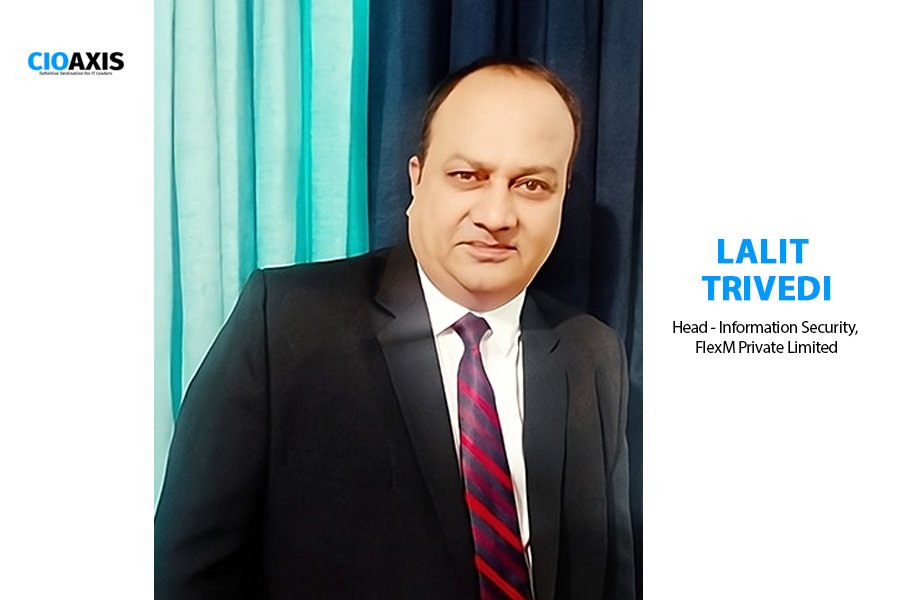In an email interview with CIOAXIS, Lalit Trivedi, Head – Information Security, FlexM Private Limited, shared his valuable insight on the various aspects of Information security and enterprise cybersecurity…
Q01. As an Infosec leader, can you describe in general terms an example of a security issue in your organization and how you managed it?
Security is a critical area of every business and every organization nowadays, threat landscape increasing in multiple folds every day and every Leader must know how to overcome this challenge.
A security leader must: Communicate to staff that protecting the system is not only in the organization’s interests, but also in the best interest of users. Increase staff awareness of security issues. Provide for appropriate staff security training. Monitor user activity to assess security implementation. and monitoring mechanism and best SOP related to security has to be in place.
Q02. As ransomware attacks is one of the key security concern for InfoSec leaders, how does your organization deal with this security threat?
Ransomware is a type of malware which prevents you from accessing your device and the data stored on it, usually by encrypting your files
Implement strong security practices, such as:
* Central device management: Limit which applications can run on devices.
* Antivirus and anti-malware: Keep software and definition files up to date.
* Security education: Train employees on security awareness.
* Network segmentation: Separate networks to limit the spread of ransomware.
* Intrusion Detection System (IDS): Monitor network traffic for malicious activity.
* AI/ML: Use AI and machine learning to detect attacks and improve security.
If an attack occurs, you can:
* Isolate affected systems: Disconnect ethernet, disable WiFi and Bluetooth, and turn off maintenance tasks.
* Determine the scope of damage: Identify the latest clean recovery point.
* Consider bringing in experts: Experts can help protect and monitor data.
* Reformat and reinstall: In some cases, you may need to reformat your hard drives and reinstall your operating system and applications.
* Don’t pay the ransom: There’s no guarantee that your files will be returned, and paying the ransom may encourage future attacks.
Q03. How can InfoSec leaders assess the effectiveness of AI in cybersecurity solutions, ease of use and its trustworthiness?
The AI trend is growing in Cyber Security because technologies and innovation done by cyber criminals in this area is far ahead then using any tools to stop cyber threats.
AI powered cybersecurity can monitor, analyze detect, and respond to cyber threats in real time. As AI algorithms analyze massive amounts of data to detect patterns that are indicative of a cyber threat, it can also scan the entire network for weaknesses to prevent common kinds of cyber attacks.
There are several steps involved in measuring cybersecurity effectiveness:
1. Risk identification and mitigation efficiently.
2. Develop cybersecurity strategies along with changing threats landscape to mitigate significant risks.
3. Select cybersecurity metrics and measures. as and when needed and improve these processes.
4. Set Benchmarks what you need and how you need and what outcome is expected.
5. Implement and test cybersecurity controls and policies to get success ratio in production environment.
6. Continuous monitoring and re-evaluation.
Q04. How crucial and practical is cost-effectiveness in your vision for the organization’s information security landscape?
Cost-effectiveness is always part of vision and business and management’s expectation. But considering Cyber Security is not a cost saving objective, it is saving business values, saving business brand, saving customer interest and critical business data.
Management can expect ROI not in terms of cost but in terms of saving business interest.
ROI can be calculated as (cost avoidance from prevented breaches, reduced downtime, and avoidance of legal fines and reputational damage).
ROI can be calculated as taking the average cost of an incident and multiplying that number by how many incidents a business might experience in a given time frame.
Q05. What are the various things that an CEO needs to be informed on the business impact of IT security and compliance changes?
CEOs often oversee vendor and partner relationships that involve sharing sensitive information. CEOS must evaluate the cybersecurity practices of these external entities to ensure that they meet the organization’s security standards. Failure to do so can expose the organization to third-party risks.
You should regularly communicate with those on your team responsible for managing cyber risks. This will allow you to be aware of threats and give you a set time to meet and strategize with your leadership team.
Make sure your company’s policies and procedures are reviewed periodically and up-to-date to account for any new laws or requirements. Also, periodically communicate these updated policies and procedures to employees. Employees should understand and be aware of their responsibilities for compliance.
As CEO you not only need to be aware of your company’s compliance requirements, and cyber threats, you also need to provide a culture to make compliance commonplace. By providing effective guidance, enforcing policies and procedures, being aware of monitoring, having open lines of communication and more, you can ensure your company meets all of its compliance requirements.
Q06. What are the crucial qualities required for becoming a futuristic InfoSec leader?
Some of the top qualities required for becoming a futuristic InfoSec leader
* Problem-Solving Skills: Able to Solve any problem in critical situations.
* Technical Aptitude: Technology Leader.
* Knowledge of Security: Across Various Platforms.
* Attention to Detail: Identify root cause not just discussions.
* Communication Skills: Ability to communicate complex concepts effectively and collaborate across departments is invaluable.
* Fundamental Computer Forensics Skills: Able to gather and analyzing digital evidence to solve cybercrimes and other crimes.
* A Desire to Learn: Hungry for learning – learning while working.
* An Understanding of Hacking: Understand in and out of hacking.
* Risk Management: Mastering this art transforms risk into opportunities and management into a strategic advantage.

